Like many of us, I’ve been concerned about reducing my carbon footprint on the planet. Being vegan helps, of course, but there’s probably always something more that we can do. One of the ways that I’ve been intrigued with for sometime is composting. Being an apartment dweller, that’s a little difficult. I have no place for a compost pile, and I have no room for a worm composting bin (nor could I tolerate the smell). But some time ago, I came across the bokashi method. Instead of breaking down your food scraps, this method pickles them. The result is a compost tea that can be used in a very dilute form to fertilize house plants as well as pickled compost that can be buried in your garden. But what do you when you don’t have a garden? I can’t fully answer that yet, as I have an experiment in progress to answer that question, but I can give you two options for the time being. One, you can throw it away. Wasteful, yes, but in its pickled state it will decompose in a landfill, as it doesn’t need light for the process because of the anaerobic microbes in the bokashi. Two, make friends with someone with a garden. Or a yard even. Of course, living in New England in the winter can make that a challenging option, even if you do know someone who would take it. It can be added to a standard compost pile as well. Stay tuned for a possible alternative for city apartment dwellers.
For now, here’s an explanation of the process.
I neglected to take a picture of the bucket unfilled, but you can see the set up here. Basically, you have a bucket that can be tightly closed with a screen that separates that solid compost from the tea. There is spigot at the bottom where the tea is drained, but more on that later.
Pictured above is food scraps with a later of bokashi on top. I started this bucket about a week ago, and I most recently added scraps two days ago. You might notice the white mold on top and on the sides- this is perfectly normal. Black mold would be bad.
These are the scraps I’m adding today. I keep a container on the counter or in the fridge to which I add scraps, so I don’t have to open the bucket every day. I’ve gone as long as a week before adding them, but I mostly only add fruit and vegetable scraps (and tea bags, as you might notice). You can add any food scraps to this, including the meat and dairy which typically can’t be added to compost, so bokashi is great for that purpose (though not eating them in the first place would be a much better option, in my opinion).
You’ll want to take a wooden spoon or other implement to mix these scraps in with the previous layer.
Once you’ve mixed them, add another layer of Bokashi.
You should add a piece of cardboard (or something similar) over the bokashi. If you don’t it won’t ruin it, but that white mold that you see on top of the cardboard and on the bokashi will get out of control if you don’t. It’s not harmful, but it is weird. The cardboard helps to maintain the anaerobic conditions that microbes in the bokashi need.
While you’ve got the bucket out anyway, it would be a good time to drain the tea. The instructions say that you need to drain every 2-3 days; I’m not convinced that often is necessary. Though what I’ve drained here is a substantial amount for only 3 days worth, it’s because I added vegetable scraps with a high water content. If your scraps are fairly dry, you won’t get this much.
If you don’t drain the tea at all, you will be sorry. I kind of missed that part in the directions with my first batch, and by the time the bucket was full, the smell was awful. Turns out that the tea was backing up into the compost, and that was a bad bad thing. When that happens, it begins to smell.
Generally speaking, there’s no smell from the bucket at all, except for when it’s open. The smell that is there isn’t the same as regular compost, because there’s nothing rotting. It’s just a sweet-sour smell. Personally, I really dislike the smell, but I manage to tolerate it. When I have to open the bucket, I make sure that the window is open as well, even when it’s freezing cold. You could light a candle or some incense too. I often do.
So what do you need to do all this? At a minimum, you need a bucket with a tight fitting lid in which you could add a drain that can be closed and a screen to separate the liquid and the solid. And bokashi, of course, which can get pricey. You *can* make your own with bran, molasses and the special EM-1 microbes (and once you’ve made it, you can use that to start more), but it’s usually made in huge batches in order to be cost-efficient. That’s not a great option for studio apartment dwellers in a city, as there’d not be any place to make or store it. You can buy it at some Whole Foods stores and on the internet. It’s about $10 for a bag. I’ve been at this for two months or so, and I’m halfway through one bag, pictured above. If you know someone with a yard and some storage space, it might be best to convince them to do this, share expenses and make it together (and then you also have someone who can take your pickled compost!).
Look for another Bokashi post in about a month, when I have some results for you in the “what-do-I-do-with-this-pickled-junk” department.

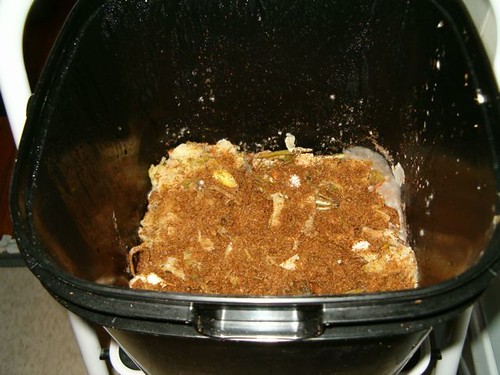


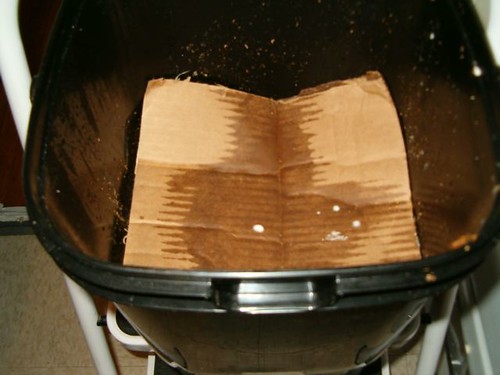
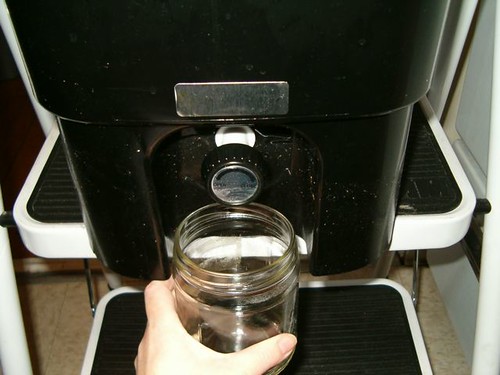
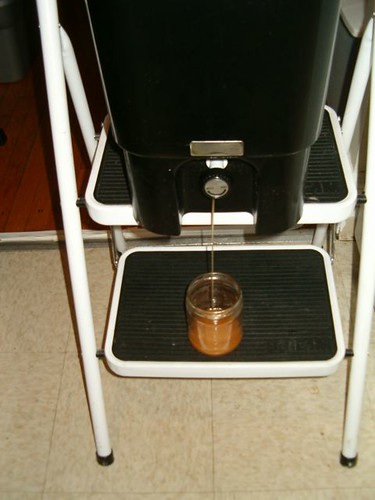
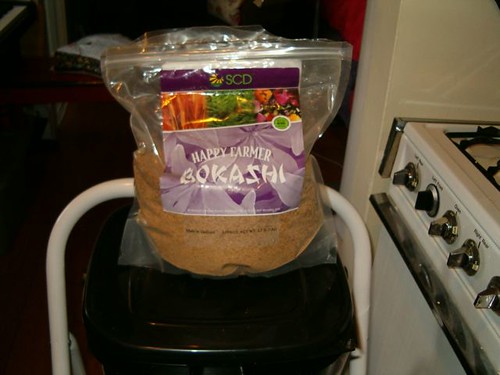

Pingback: Composting Tips - Anaerobic Composting